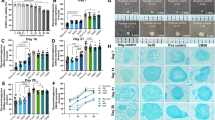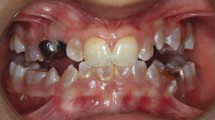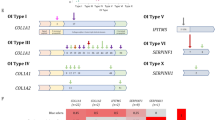Abstract
Clinical and biochemical findings in 5 unrelated patients with osteogenesis imperfecta (OI) with a serine for glycine substitution in the α2(I) collagen chain are presented. The data are compared to other serine substitutions in collagen type I. Findings show that the phenotypic severity of serine for glycine substitutions in the α2(I) collagen chain is region dependent similar to the observations for the α1(I) collagen chain, and that so-called ‘lethal’ and ‘non-lethal’ domains in the α1 and α2 collagen chains do not necessarily correspond.
Similar content being viewed by others
Log in or create a free account to read this content
Gain free access to this article, as well as selected content from this journal and more on nature.com
or
References
Sillence DO, Senn A, Danks DM: Genetic heterogeneity in osteogenesis imperfecta. J Med Genet 1979;16:101–116.
Byers PH: Osteogenesis imperfecta; in Royce PM, Steinmann B (eds): Connective tissue and its heritable disorders: Molecular, genetic and medical aspects. New York, Wiley-Liss, 1993, pp 317–350.
Kuivaniemi H, Tromp G, Prockop DJ: Mutations in collagen genes: Causes of rare and some common diseases in humans. FASEB J 1991;5: 2052–2060.
Nuytinck L, Narcisi P, Nicholls A, Renard JP, Pope FM, De Paepe A: Detection and characterisation of an overmodified type III collagen by analysis of non-cutaneous connective tissues in a patient with Ehlers-Danlos syndrome IV. J Med Genet 1992;29:375–380.
Bruckner P, Prockop DJ: Proteolytic enzymes as probes for the triple-helical conformation of procollagen. Anal Biochem 1981; 110:360–368.
Barsh GS, Peterson KE, Byers PJ: Peptide mapping of collagen chains using CNBr cleavage of proteins within Polyacrylamide gels. Collagen Rel Res 1981;1:543–548.
Mackay K, Byers PH, Dalgleish R: An RTPCR-SSCP strategy for detection of mutations in the gene encoding the α1 chain of type I collagen: Application to four patients with osteogenesis imperfecta. Hum Mol Genet 1993;2: 1155–1160.
Ganguly A, Rock M, Prockop DJ: Conformation-sensitive gel electrophoresis for rapid detection of single-base differences in double-stranded PCR products and DNA fragments: Evidence for solvent-induced bends in DNA heteroduplexes. Proc Natl Acad Sci USA 1993; 90:10325–10329.
Sanger R, Nicklen FS, Coulson AR: DNA sequencing with chain-termination inhibitors. Proc Natl Acad Sci USA 1979;74:5463–5467.
Pruchno CJ, Cohn DH, Wallis GA, Willing MC, Starman BJ, Zhang X, Byers PH: Osteogenesis imperfecta due to recurrent point mutations at CpG dinucleotides in the COL1A1 gene of type I collagen. Hum Genet 1991;87: 33–40.
Rose NJ, Mackay K, Byers PH, Dalgleish R: A Gly859Ser substitution in the triple helical domain of the α2 chain of type I collagen resulting in osteogenesis imperfecta type III in two unrelated individuals. Hum Mut 1994;3:391–394.
Rose NJ, Mackay K, Byers PH, Dalgleish R: A Gly238Ser substitution in the α2 chain of type I collagen results in osteogenesis imperfecta type III. Hum Genet 1995;95:215–218.
Cole WG, Dalgleish R: Perinatal lethal osteogenesis imperfecta. J Med Genet 1995;32:284–289.
Mottes M, Gomez Lira MM, Valli M, Scarano G, Lonardo F, Forlino A, Cetta G, Pignatti PF: Paternal mosaicism for a COL1A1 dominant mutation (al Ser-415) causes recurrent osteogenesis imperfecta. Hum Mut 1993;2:196–204.
Superti-Furga A, Pistone F, Romano C, Steinmann B: Clinical variability of osteogenesis imperfecta linked to COL1A2 and associated with a structural defect in the type I collagen molecule. J Med Genet 1989;26:358–362.
Dyne KM, Valli M, Forlino A, Mottes M, Kresse H, Cetta G: Deficient expression of the small proteoglycan decorin in a case of severe/lethal osteogenesis imperfecta. Am J Med Genet 1996;63:161–166.
Sakai LY, Burgeson RE, Olsen BR, Rowe DW, Gordon SL: Current knowledge and research directions in heritable disorders of connective tissue. Matrix Biol 1996; 15:211–229.
Zhuang J, Tromp G, Kuivaniemi H, Castells S, Bugge M, Prockop DJ: Direct sequencing of PCR products derived from cDNAs for the proα1 and proα2 chains of type I procollagen as a screening method to detect mutation in patients with osteogenesis imperfecta. Hum Mut 1996;7:89–99.
Westerhausen A, Kishi J, Prockop DJ: Mutations that substitute serine for glycine α1-598 and glycine α1-631 in type I procollagen. J Biol Chem 1990;265:13995–14000.
Spotila LD, Constantinou CD, Sereda L, Ganguly A, Riggs BL, Prockop DJ: Mutation in a gene for type I procollagen (COL1A2) in a woman with postmenopausal osteoporosis: Evidence for phenotypic and genotypic overlap with mild osteogenesis imperfecta. Proc Natl Acad Sci USA 1991;88:5423–5427.
Nuytinck L, Dalgleish R, Spotila L, Renard JP, Van Regemorter N, De Paepe A: Substitution of glycine-661 by serine in the α1(I) and α2(I) chains of type I collagen results in different clinical and biochemical phenotypes. Hum Genet 1996;97:324–329.
Acknowledgements
We are grateful to J.P. Renard and M. Van Thielen for excellent technical assistance. We are endebted to Dr. P. Byers and Dr. A. Lund for permission to report results communicated to the Osteogenesis Imperfecta Mutation Consortium but not yet published. This work was supported by the Fund of Scientific Research, Flanders, Belgium.
Author information
Authors and Affiliations
Corresponding author
Rights and permissions
About this article
Cite this article
Nuytinck, L., Wettinck, K., Freund, M. et al. Osteogenesis imperfecta Phenotypes Resulting from Serine for Glycine Substitutions in the α2(I) Collagen Chain. Eur J Hum Genet 5, 161–167 (1997). https://doi.org/10.1007/BF03405894
Received:
Revised:
Accepted:
Issue date:
DOI: https://doi.org/10.1007/BF03405894



